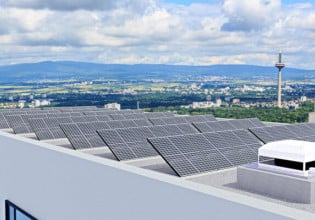EU Reassessing Building Energy Efficiency and Performance
Inside the effort to reform Europe’s energy performance standards to include newer implementation around retrofitting and renovating old and inefficient buildings.
Mandatory in every sale, lease, or rent contract, energy performance certificates (EPCs) are considered part of everyday business in Europe’s building sector. EPCs inform tenants and home buyers about energy demand and consumption, information that can be used to gauge the cost of heating.
A European Union-funded consortium called TIMEPAC is designing a framework to modernize Europe’s building performance certificate process. Image used courtesy of TIMEPAC
While this bureaucracy is generally a one-off occurrence, groups pushing EPC reform argue it misses the opportunity to collect crucial data on a building’s actual performance, present-day conditions, past renovations, and capacity to integrate renewable and distributed energy systems such as rooftop solar panels or electric vehicle-to-grid installations.
So arises an effort to find a use for the EPC data collected over the last decade and manage higher-quality data in the coming years. The European Union (EU), which aims to renovate tens of millions of inefficient buildings before 2030, is looking to modernize the current building performance status quo for its 27 member states. To that effect, it awarded a three-year grant in 2021 totaling 1.99 million euros ($2.1 million) to a consortium called Towards Innovative Methods for Energy Performance Assessment and Certification (or TIMEPAC) to switch the EU’s EPC system from a static certification to a dynamic process.
TIMEPAC is working on combining EPC databases with other sources to increase the certification’s reliability. Its framework views buildings as continuously evolving products of a connected network of energy distribution and transport systems. The group is redesigning the EPC dataflows to include generation, storage, sustainability, readiness for smart technologies, and other factors across the building’s lifecycle.
TIMEPAC’s Approach
TIMEPAC is currently testing its methods in six EU nations. The organization estimates that improved EPCs will enable 6.5 square meters of additional renovation per year in the six pilot countries, yielding an average of 85 kilowatt-hours per square meter of primary energy savings.
A presentation slide from a TIMEPAC workshop in 2022. Image used courtesy of TIMEPAC
With the EU grant project window over halfway complete (July 2021 to June 2024), TIMEPAC has hosted several workshops and organized reports outlining its data analysis. It recently released an industry survey calling on building experts to help identify barriers to implementing new EPCs.
Worth noting: TIMEPAC acknowledges that EPC reform will involve incentives. While the current process is generally cheap, firms and individuals would be less willing to pay for detailed reports and make energy efficiency improvements. It’s developing an online platform with training materials tailored to key target users, such as certification professionals, architects, building managers and owners, tenants, and other stakeholders.
The EU’s motivation to reform its building performance regulations is part of its 2030 target to reduce greenhouse gas (GHG) emissions by 55% compared to 1990.
According to European Commission statistics, buildings account for 40% of EU energy consumption and 36% of energy-related GHG emissions. About one-third of all EU buildings are over 50 years old, and nearly 75% of the building stock is not energy efficient, with only about 1% undergoing renovation each year.
Modernizing Existing EU Regulations
The EU already has regulations governing building performance and efficiency, requiring EPCs for any sale or rent of building property. In 2010 and 2012, it cast the Energy Performance of Buildings Directive and the Energy Efficiency Directive. Both policies were amended to add new clean energy and modernization elements, including a 2030 efficiency target of 32.5%.
In 2020, the European Green Deal solidified these efforts with more direct regulatory and financing functions for building renovation, aiming to at least double the annual energy renovation rate by 2030. The Green Deal’s “Renovation Wave” component was designed to increase renovation uptake, targeting 35 million inefficient buildings by the decade's end.
The EU later revised these policies in 2021 with a proposal to reduce emissions in the building sector by 60% by 2030. The update added new minimum requirements for building performance: The worst-performing 15% of EU building stock would need to upgrade from a label G to at least a label F by 2030, with public and non-residential buildings on an expedited timescale by 2027. And residential facilities must be renovated from G to at least F by 2030 and E by 2033.
Negotiations on future changes are ongoing between EU leaders. In addition to the minimum standards mentioned above, the proposed amendments would add a Smart Readiness Indicator (SRI) scheme by 2025. SRIs, which assess energy efficient control strategies and grid interaction (flexibility/demand response), are currently optional, with pilot tests underway in eight EU countries.
Video used courtesy of the European Science Communication Institute
TIMEPAC is collecting and synthesizing data from its six pilot nations to inform the revised Energy Performance of Buildings Directive, establishing minimum performance levels and new tools to incentivize upgrades. TIMEPAC’s framework assesses a building’s readiness for sustainability-focused upgrades and ability to accommodate smart devices, drawing data from building information modeling records, technical building inspections, building materials, and operation data.
EPCs Elsewhere
The United States, where residential and commercial buildings account for 40% of total energy consumption, has recently implemented new building standards, albeit on a smaller scale than Europe’s more sweeping measures.
In December 2022, President Joe Biden introduced the nation’s first Federal Building Performance Standard, aiming to reduce energy use and electrify equipment/appliances in 30% of federal government-owned building space by 2030.
Several state and city governments have also signed on to the National Building Performance Standards Coalition. The group’s members have committed to identifying prerequisites for building performance standards and advancing relevant legislation or regulation in their jurisdictions by April 2024.








